Parts of a MetroCluster IP configuration
As you plan your MetroCluster IP configuration, you should understand the hardware components and how they interconnect.
Key hardware elements
A MetroCluster IP configuration includes the following key hardware elements:
Storage controllers
The storage controllers are configured as two two-node clusters.
IP network
This back-end IP network provides connectivity for two distinct uses:
Standard cluster connectivity for intra-cluster communications.
This is the same cluster switch functionality used in non-MetroCluster switched ONTAP clusters.
MetroCluster back-end connectivity for replication of storage data and non-volatile cache.
Cluster peering network
The cluster peering network provides connectivity for mirroring of the cluster configuration, which includes storage virtual machine (SVM) configuration. The configuration of all of the SVMs on one cluster is mirrored to the partner cluster.

Disaster Recovery (DR) groups
A MetroCluster IP configuration consists of one DR group of four nodes.
The following illustration shows the organization of nodes in a four-node MetroCluster configuration:
